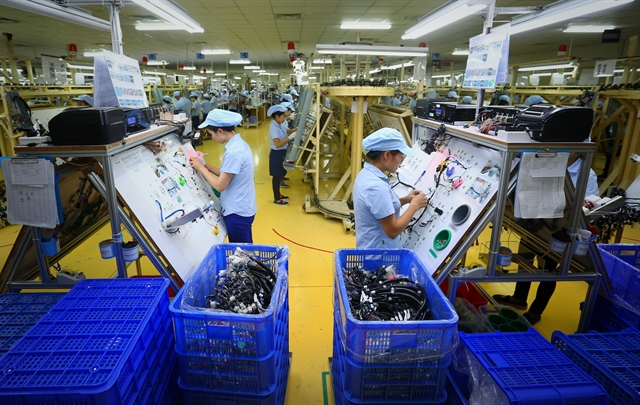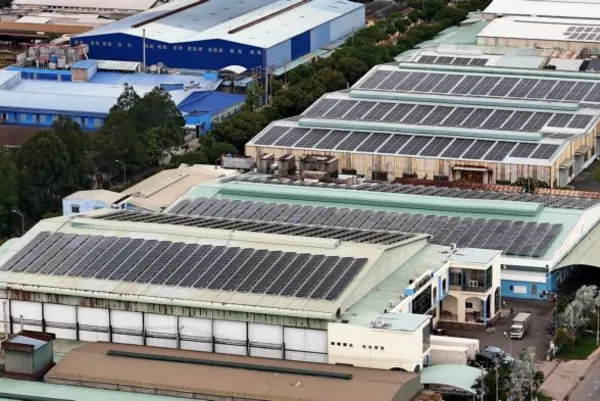 Economy
Economy


|
| An electronic component production line in Vĩnh Phúc Province. — VNA/VNS Photo |
HÀ NỘI — Việt Nam's Gross Domestic Product (GDP) target of 6-6.5 per cent in 2024 is feasible, but the Government needs to make efforts to take comprehensive, drastic measures to realise the goal, said National Assembly (NA) deputies and socio-economic experts.
The NA last week approved the socio-economic development plan for next year, which sets the GDP growth target at 6-6.5 per cent and income per capita at US$4,700-4,730.
Chairman of the NA Economic Committee Vũ Hồng Thanh said that during the building and making adjustments to the draft resolution, some deputies held that amid the current situation, the goal of 6.0-6.5 per cent in GDP growth is relatively high, and recommended lowering the goal to 5-6 per cent.
However, he said that the GDP growth target was set on the foundation of analysis and forecast of the domestic and international situation, taking into account advantages and difficulties in 2024, and following the tasks and targets set in the five-year socio-economic development plan.
In particular, growth drivers of investment (private, FDI, public investment, State-owned enterprises), consumption, tourism, and export are strongly promoted. Many important and key national projects with pervasive impacts are being accelerated into operation, he said.
Trần Văn Lâm, deputy head of the Bắc Giang Province’s NA deputy delegation, member of the NA’s Finance-Budget Committee, said the GDP target is feasible given the current context and three growth drivers – export, investment, and consumption.
He said exports were suppressed but at the end of the year have recovered very well with good prospects. Increasing global market demand and recovering domestic market will push the recovery of exports.
Việt Nam will kick off comprehensive salary reform in 2024, which will create huge demand and boost economic growth, he said.
Việt Nam will also maintain the investment pace, he said, adding: “Looking at all three factors – export, investment, and consumption, if there are no adverse or sudden factors, we can completely achieve and even exceed the goal.”
NA deputy Hoàng Văn Cường from Hà Nội said: "There are enough preconditions, both external and internal factors, to expect that we will achieve a high growth rate by 2024."
To achieve the GDP growth target of 6-6.5 per cent, he said Việt Nam needs to make great efforts to seize the opportunity.
“First of all, it is necessary to drastically resolve institutional bottlenecks to free up resources so we can quickly grasp new opportunities,” he said.
He also proposed new and supportive policies be put into place and, especially, added tax policy supporting the business sector. Việt Nam must also quickly grasp new market opportunities and market changes to expand consumption markets and restructure businesses.
Regarding the 12 solutions proposed by the NA to achieve the growth target, Cường said the solutions are comprehensive and complete. However, the biggest bottleneck Việt Nam has faced today is institutions.
He cited overlapping legal documents inconsistent with reality as an example of institutional shortcomings.
Dr Nguyễn Đình Cung, former director of the Central Institute of Economic Management, proposed the Government and the NA extend socio-economic recovery support programmes until 2024 and 2025 to promote consumption.
There needs to be a support programme for service and tourism businesses to revive this industry, because tourism makes an important contribution to GDP, he said.
He also proposed the Government improve the business environment, eliminate procedures and conditions that are hindering business operations instead of simplifying processes causing difficulties.
He recommended the Government and Prime Minister list about five to 10 issues that are the most pressing and hindering, then assign tasks to specific units to address.
Economic expert Trần Du Lịch, member of the National Financial and Monetary Policy Advisory Council, said given the headwinds that may last until 2024, "we need to build institutions and policies to create a foundation for recovery and stronger growth in the next period".
Amidst general global headwinds, Việt Nam has shown many positive signs. However, it is necessary to remove bottlenecks effectively when the businesses can still withstand, he said.
He emphasised the need to focus on solving problems in the real estate market on both the supply and demand sides, especially consolidating the financial market to create a solid foundation for the macro-economy.
Shanaka Peiris, Division Chief of Regional Studies at the International Monetary Fund (IMF)’s Asia and Pacific Department (APD), said Việt Nam faces difficulties in export, real estate and financial sectors, but its economy is recovering.
When reform measures are implemented, Việt Nam will overcome "short-term headwinds" and will maintain growth momentum in the medium term, based on integration into value supply chains as well as foreign direct investment, he said.
ADB Country Director for Việt Nam Shantanu Chakraborty said that domestic consumption, export and public investment will be the main growth drivers of Việt Nam’s economy in 2024.
Maintaining the pace of public investment will be crucial to rejuvenate economic activity, generate employment, and enhance domestic consumption, he said.
By some estimates, there is about $30 billion of public investment that has been planned by Việt Nam, so concerted efforts need to be made to expedite spending the money. That will really boost demand in the market, lead to employment generation, and foster overall economic activities, he said.
Head of the International Monetary Fund (IMF) 2023 Article IV Mission to Việt Nam Paulo Medas said that in the short term, downside risks to growth remain large. Further efforts to safeguard macro-economic and financial stability and accelerate reforms will ensure that the economy remains on a safe footing. The policy mix should be re-balanced with greater emphasis on fiscal support to the economy and the most vulnerable. — VNS




